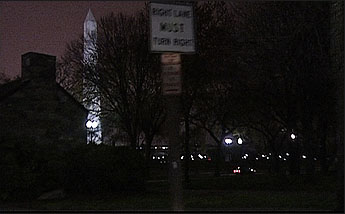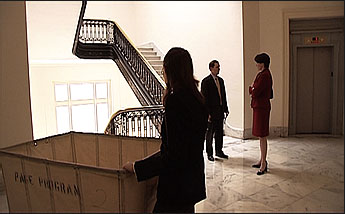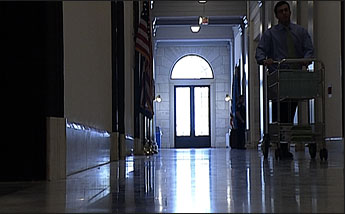

We've been working on these films for a very long time now -- almost nine years, getting awfully close to a decade. It's been truly the opportunity of a lifetime. But looking back, there's no denying -- we had no idea what we were getting into back in the summer of 2001.
We'd each made a lot of films by then, and had spent about a year showing our most recent one, Well-Founded Fear, to audiences around the country. It's a film about political asylum in the U.S. So we knew that immigration, and pretty much everything linked to it like political asylum, opened up all kinds of interesting discussions. Then, just about the time we were looking for a subject for our next show, the news started to focus on the possibility of a big and somewhat revolutionary reform of America's entire immigration system. The new President wanted it, and so did a surprising group of other powerful people.
We jumped in, not really so much to follow the immigration story, but more the drama of a social movement as it meshed/aligned with a large political wave. There was a sense in the air that the growing immigrants rights movement, like the civil rights movement 40 years earlier, might again transform the country. All signs indicated that within a year there would be a monumental political battle over immigration legislation. That side of this story was a new universe for us, and seemed like a momentous though maybe impossible opportunity for a movie.
We could see that if this thing was really happening and we could get into many different places where individual players were actually involved -- people working in Congress, lobbyists, labor unions, advocates and activists -- we could piece together for viewers a window into the process of creating social change and how it meshed with the machinery of politics in the United States. And that August, it all seemed to be happening very fast -- so fast, that if we wanted to follow it, we'd have to buy a new camera with a credit card.
Our plan was to shoot multiple, in-depth cinema-verité narratives simultaneously, then knit them together to illustrate the full national story, or even, if it happened, what might well be big enough to count as history. The biggest challenge at the beginning was just figuring out how to get started. There were so very many people to meet and persuade that this idea of a documentary of "how democracy works" was not crazy, or directly counter to any concept of their own self-interest. The going was slow but a lot was happening, and that worked in our favor. For that first week in September, 2001, along with the Chandra Levy story, immigration was at the top of the national news.
We'd only been shooting for a couple of weeks though, and were barely getting started in the Senate when the attacks on September 11th, 2001 changed the course of US immigration history forever. Like almost everything else, immigration became just one more issue put aside as the country, and certainly Washington, DC, focused everything on the new reality of national security. There was nothing for us to shoot in Washington the next week. And nobody we'd been filming with really wanted to see us.
Many times over the years, we've wondered whether we shouldn't have stopped right then. Lots of film projects just don't work out. The key to survival as an independent is to recognize those and cut your losses in time. We'd done that in the past. This film idea barely started seemed like the least of the big problems - or even the big stories - right then, but somehow, we really didn't want to let it go. The idea of understanding what was inside that black box that fits between elections, how democracy worked in the America of the 21st century, had already gotten too deep a hold on us.
We stayed away from Washington for a while, and remembered a story we simply hadn't managed to shoot that had happened in Iowa over the previous summer. A local group of anti-immigration supporters had managed to hijack the High School Band's summer parade, and in the process, attract the attention of the national news which was zeroing in on anything and everything "immigration" at that point. We went out to see what was left.
There were wonderful possibilities for all sorts of documentaries right then in Iowa, of course. But with the 'how democracy works now' perspective, following the local City Council race in Mason City became our first object lesson in the big construct that ended up being the M.O. of the series and every film in it. The complicated ways that quite personal stories, particular immediate contexts and histories, accidents and coincidence play into an abstractly articulated framework of broad social policy goals and specific political aims to become the material of democracy -- that's what we ended up filming, and eventually editing to make these films.
We went back to Washington after the November elections in Iowa, and began our series of introductions and persuasion-assaults again. It wasn't exactly easy going, but it was fascinating. Gradually things began to melt a bit, and by winter 2002, we were on the way. We started following the immigration issue again in the very generous office of Senator Sam Brownback, and began to spread from there to other offices in the Senate. When Senator Ted Kennedy agreed to participate and help us with the project a month or so later, we were truly on the way.
The plan was to travel between Capitol Hill and the rest of the country as stories took us there. If we were willing to take the risk, we had the luxury of following whatever seemed to be happening. And it was amazing exactly how it was that one thing led to another. As we began to understand the political reality surrounding the immigration reform issue, we branched out to film things that were not specifically "immigration" (like primary campaigns and inter-office politics) because they had a direct bearing on other things that were.
Very soon we were in way over our heads. It was great. And we felt immensely privileged because … no one ever sees this, quite this way. It's too huge, too sprawling, far too random and entropic. As filmmakers, we began by wanting to understand it and pass that on, but we had no idea it would be so rich, so necessarily reducible to small stories, individual lives, personal aspirations that intersect and cross back in all sorts of beautiful, unexpected ways. And we surely had no idea how much we had to learn.
We kept at it for another 5 years. We learned how local and state elections and ballot campaigns can be used to influence the Congress, we saw how personal rivalries could turn an organized movement to confusion, we got an education in ways the procedural rules of the Senate, used deftly, can have enormous impact on the daily lives of average Americans, we learned the mysteriously powerful craft of media training and the mastery of talking points. We saw a few things that surprised us, too -- how a Senator might decide to change a vote as a result of just a few dozen constituent calls, how deep the relationships between people on opposite sides of an issue, or political party, can become over the years from working 'together', how genuine the desire to serve the public interest can be on Capitol Hill.
Sometimes, immigration was happening again, and we just had trouble keeping up. Other periods it was less easy to see where the issue was going. Over the six years we shot, political dominance shifted through several combinations of Republican and Democratic ascendance. The White House moved from being very interested in achieving a historic immigration reform, to being so involved with other huge issues that immigration was simply a bother, to finally near the end of president Bush's administration, struggling to take up challenge once more. From 2001 to 2007, the organized groups opposed to increased immigration and most plans floated for immigration reform grew much stronger. Those voices had hardly been on the horizon when we began, and by the end, they dominated the debate.
As we seem to say pretty often, we just kept filming. (Except for when we went out of business a couple of times.) The nature of the material varied a lot, partly because different things were happening but also because we'd have different relationships in different places. The story continued to broaden from the summer of 2001 to probably it's widest point around the elections in November 2004. At that stage, we had apartments in Washington, Phoenix and New York, and were shooting 7 days a week somewhere. Our story began to retract and refocus again in 2005, as five legislators who'd written competing bills in earlier years -- Senators Kennedy and McCain and Congressmen Flake, Kolbe and Gutierrez -- all teamed up to introduce a Comprehensive Immigration Reform bill.
From that 2005 shoot on, we were also starting the edit, and our material once again centered on immigration, although now with the benefit of having learned an awful lot about politics, government and how the legislation process actually works. The most triumphant moment we filmed was in 2006, when Senators Kennedy and McCain actually managed to get their bill passed in the Senate. The next year, so much was different, and our film of 2007 is almost the opposite of earlier ones were -- very tight and very deep on one angle of the story. You might say, it took all that work in the years earlier to prepare us to make Last, Best Chance.
On Thursday, June 28, 2007, with the defeat of the Senate bill, everything changed. That afternoon we put the camera gear down for the first time all month, and even in the first stunned moment after the postmortem press conferences, we understood in our bones something very new -- we were finished, our story had found its ending.
The debate during those weeks through the spring and early summer of 2007 exposed the return of a dark vein in American society that hadn't been public, or socially acceptable, since the '60s. It was hard not to to hear an echo of the Civil Rights struggle in the skirmishes. The final vote was devastating. It will prove to be a landmark..
It's not the ending we would have written. But it is, effectively, the end of our story. The immigration issue is not about to go away. In spite of the great ideas, the problems at its core haven't been touched. But our hope is that, in and through their small personal stories, this set of films will now deliver on their potential, as especially movies can, to contribute to much deeper public understanding of this process and this debate when it happens again.
And even beyond that, we think the films can contribute to understanding many other debates as well. Most of these stories are universals in the realm of How Democracy Works Now. Many of the people who so generously let us film them and make their lives terribly uncomfortable -- for years! -- understood that from the start. Our hope is that if you watch the shows, and get to know Esther or Frank or Alfredo, or Randy, Margaret, Becky, pretty much any of our friends who helped us get these movies made, they will inspire you to be a more active participant in the running of this country. Because in the end, that's the biggest thing we learned through all these years making the series. Our democracy does in fact work -- it mirrors back what goes into it surprisingly efficiently for the complexity involved. But our democracy, and maybe any democracy, can only really work when all the people living in it take responsibility, and take part.













